
Switzerland - Zentralbahn
For a full scale picture, please click on the picture shown !

The company Zentralbahn ZB came into existence in 2005 as a fusion product of the private LSE Luzern-Stans-Engelbergbahn and the
SBB Brünigbahn, which was a part of the federal Swiss railways SBB. They both operated on a meter gauge network, partly three rail
cogwheel. At the city of Luzern they shared a common part of track from Luzern to Stansstad. LSE's line continued from there to the
famous skiing resort of Engelberg, whereas Brünigbahn's line climbed over the mountains via the Brünig pass and continued all the way
to Interlaken. Now as Zentralbahn these two companies have continued as one. A lot of renewal work has been done. Very expensive track
renewals happened at the former LSE line, including the construction of a new over 4 km long tunnel, the Grafenort to Engelberg tunnel,
and Zentralbahn has also almost completely gotten rid of their old trains, replacing them
with a more standardised fleet of electric multiple units built by Stadler. Flat land services close to the city of Luzern are served
by trains of the type SPATZ, which has large panorama windows. Lines climbing high up to Engelberg or over the Brünig pass are served
with three rail cog wheel capable units called ADLER (a seven coaches long train) or FINK (a three coaches long fixed train).
This is a three coach Stadler SPATZ class ABe 130 train with some extra old coaches fitted at the end, here ready to leave from Luzern
towards the former LSE line to Engelberg.
Picture from Luzern 1.5.2016 by Ilkka Siissalo.
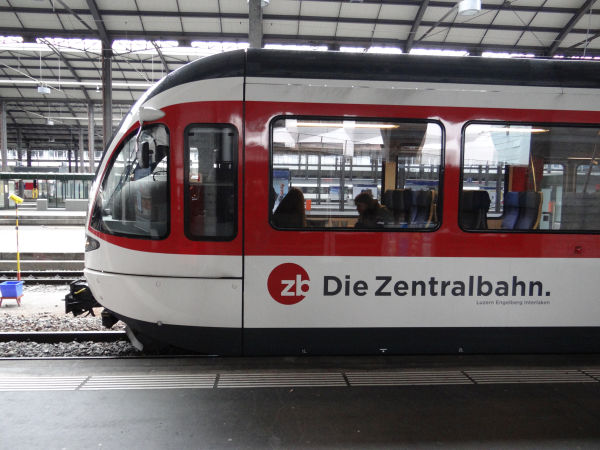
The same train as above. The driver's cab of a Stadler SPATZ is very similar to the ones of Stadler's GTW or FLIRT trains, but it
is shorter.
Picture from Luzern 1.5.2016 by Ilkka Siissalo.

Still the same train as above. When the capacity of one three coach SPATZ unit was not enough, two old but renovated formerly LSE coaches
one of which has a driver's cab were added to form a longer rush hour train.
Picture from Luzern 1.5.2016 by Ilkka Siissalo.
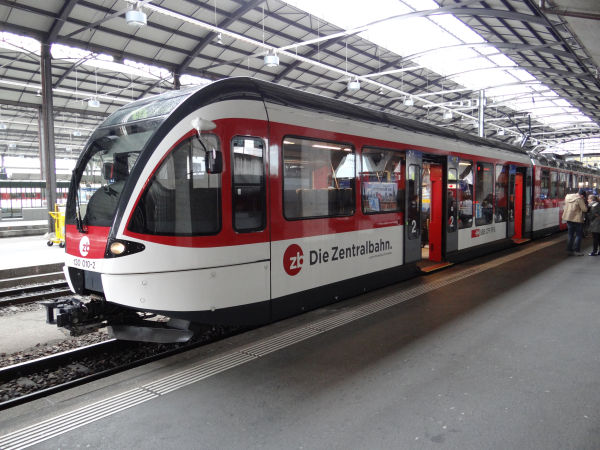
Another class ABe 130 SPATZ three coaches long train.
Picture from Luzern 1.5.2016 by Ilkka Siissalo.
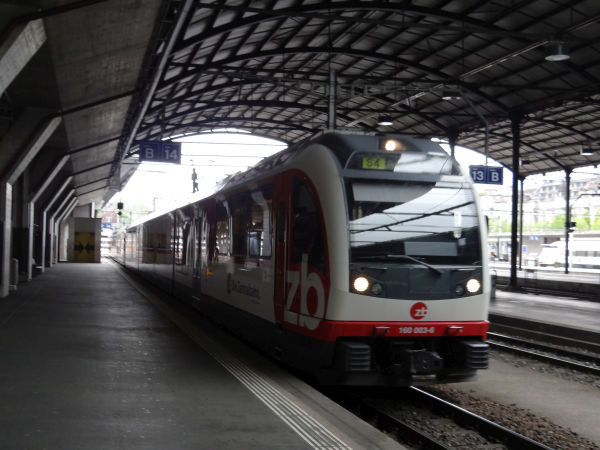
A three coaches long class ABeh 160 FINK train is arriving at the station of Luzern.
Picture from Luzern 1.5.2016 by Ilkka Siissalo.
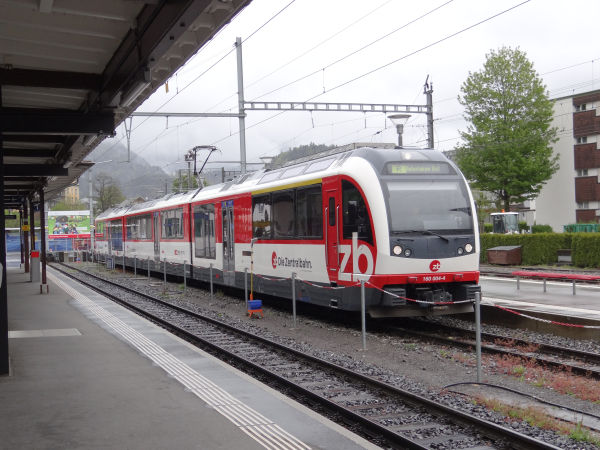
The flatland route section from Interlaken Ost to Meiringen has a frequent service which is normally served by the class
130 trains which have no cog wheel third rail systems. But sometines - like here - also this short route is run by ABeh 160
FINK trains, which actually do have the mountain line equipment not needed on this part of the line.
Picture from Meiringen 1.5.2016 by Ilkka Siissalo.
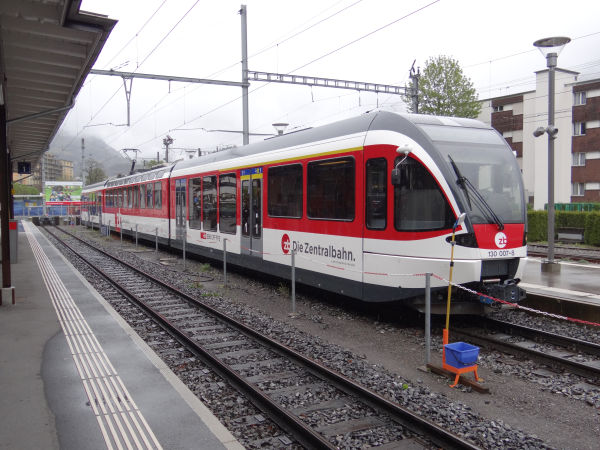
The next train on the same flatland route from Meiringen to Interlaken Ost was a class ABe 130 SPATZ.
Picture from Meiringen 1.5.2016 by Ilkka Siissalo.
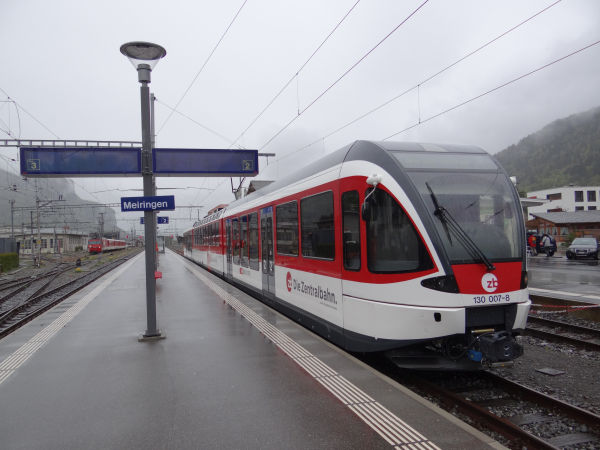
The same train as above, but seen from the other side. A class ABe 130 SPATZ.
Picture from Meiringen 1.5.2016 by Ilkka Siissalo.
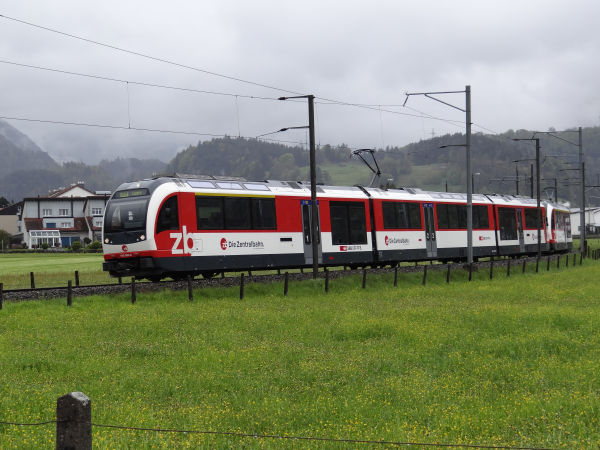
Zentralbahn InterRegio service from Interlaken to Luzern is approaching the station of Meiringen. The train is composed of
two class ABeh 160 FINK three coach units.
Picture from Luzern 1.5.2016 by Ilkka Siissalo.
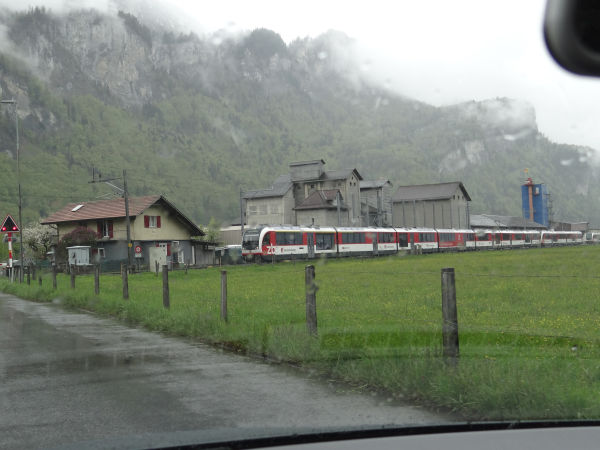
An InterCity train composed of a seven coaches long Stadler ADLER plus a three coaches long Stadler FINK unit is approaching
a road crossing on a rainy day and will soon reach Meiringen station.
Picture from Meiringen 1.5.2016 by Ilkka Siissalo.
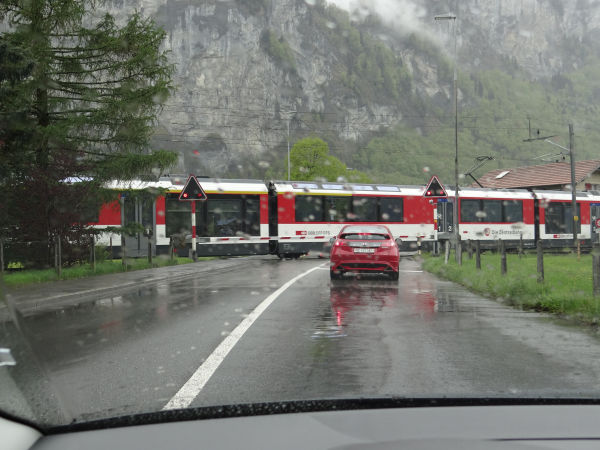
Same train as above. The ADLER unit is just at the level crossing.
Picture from Meiringen 1.5.2016 by Ilkka Siissalo.

A class Abeh 161 Stadler FINK train, totally brand new and here still not even officially received from the manufacturer Stadler
to Zentralbahn. This new train is from the second generation of FINK trains. The second series has so many improvements over the
first one that it was classed as class 161 instead of the original class 160.
Picture from Meiringen 1.5.2016 by Ilkka Siissalo.

A closeup of the front of the same brand new FINK as above.
Picture from Meiringen 1.5.2016 by Ilkka Siissalo.
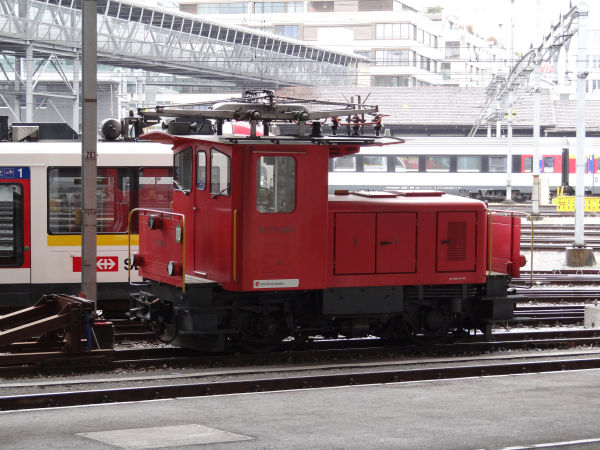
Electric cog wheel rail tractor Zentralbahn Te 171 still before its modernisation. It is of the type Te III and it was built by
SLM and SAAS in 1962. In 2011 this same machine was like brand new, all renovated and carried the emblem and name of the town of
Meiringen.Its max speed is 60 km/h, it weighs 26 tons and has a power rating of 257 kW. It works with 1,5 kV DC as is customary
at the Zentralbahn.
Picture from Luzern 1.5.2016 by Ilkka Siissalo.
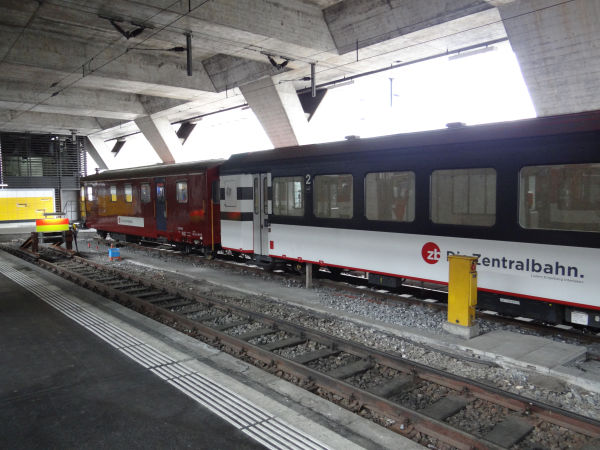
Old Brünigbahn's coaches act as a cafeteria and waiting room for Zentralbahn's personnel in Luzern.
Picture from Luzern 1.5.2016 by Ilkka Siissalo.
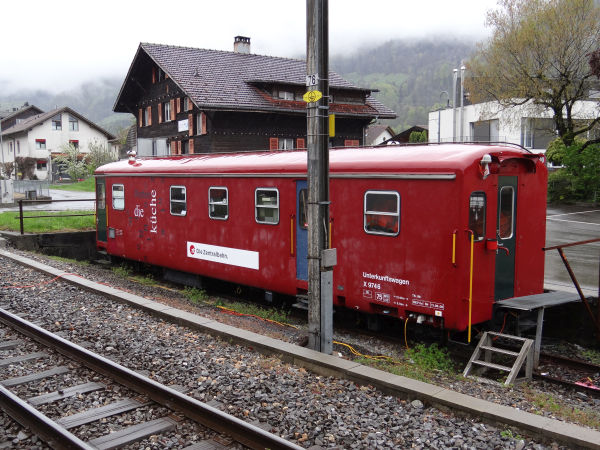
"Die Küche" = the kitchen. Another old Brünigbahn coach which now acts as a canteen and social room for Zentralbahn's workers.
Picture from Meiringen 1.5.2016 by Ilkka Siissalo.
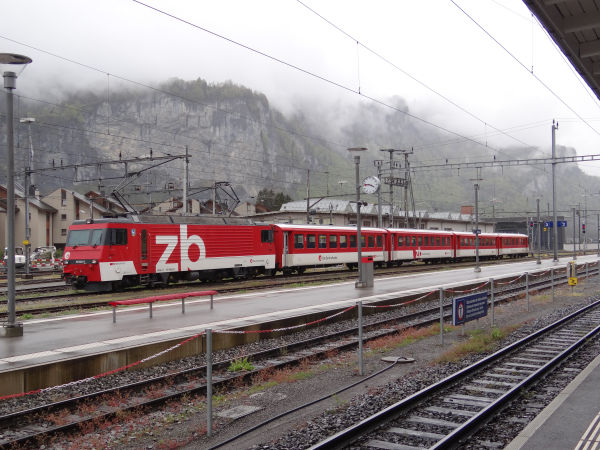
In the old Brünigbahn times this HGe 101 locomotive and its old coaches was the newest and finest that there ever was. But now the
locomotive and its set of coaches is just a reserve that would jump in as a replacement, should some one of the new Stadler trains
fail for some reason.
Picture from Meiringen 1.5.2016 by Ilkka Siissalo.

The Hge 101 (sometimes also referred to as HGe 4/4 101 or simply as HGe 4/4) was built for the companies Furka-Oberalpbahn FO (now a part of Matterhorn-
Gotthardbahn MGB), Brig-Visp-Zermattbahn BVZ (now also a part of MGB) and SBB Brünigbahn, now a part of Zentralbahn. There were 5
prototypes and 16 production series locomotives and they were first run in 1985. FO/BVZ/MGB machines run on 11 kV AC and these SBB
Brünigbahn/Zentralbahn machines on 15 kV 16,7 Hz. Their top speed on adhesion lines on flat land is 100 km/h and 40 km/h when using third
rail cog wheel drive.
Picture from Meiringen 1.5.2016 by Ilkka Siissalo.

The metre gauge diesel locomotive HGm 104 no.002 seen here with a metre gauge tamper machine of the company Vanomag AG is used for
track maintenance purposes. Zentralbahn has two of these machines and they are from the year 2005. They have also third rail cog
wheel drives of the system Riggenbach so that they can operate on even the steepest slopes of the mountainous lines.
Picture from Meiringen 1.5.2016 by Ilkka Siissalo.
Former LSE Luzern-Stans-Engelbergbahn
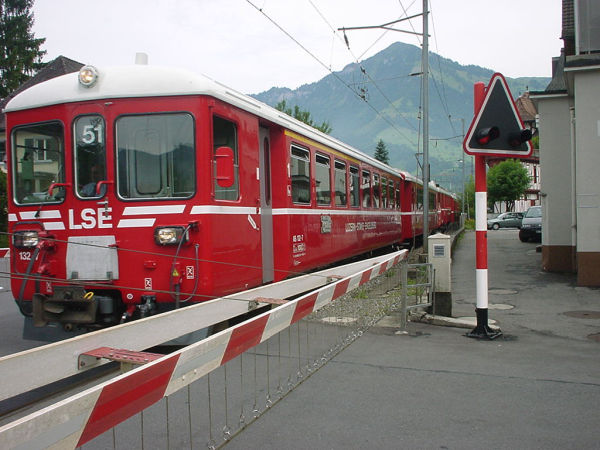
This picture is still from the times of the old LSE Luzern-Stans-Engelbergbahn. This is a flatland service, kind of a suburban
commuter service between Luzern and Stansstad, here arriving at Stansstad.
Picture of a push-pull commuter train of LSE 21.7.2002 at Stansstad by Ilkka Siissalo.
Former SBB Brünigbahn
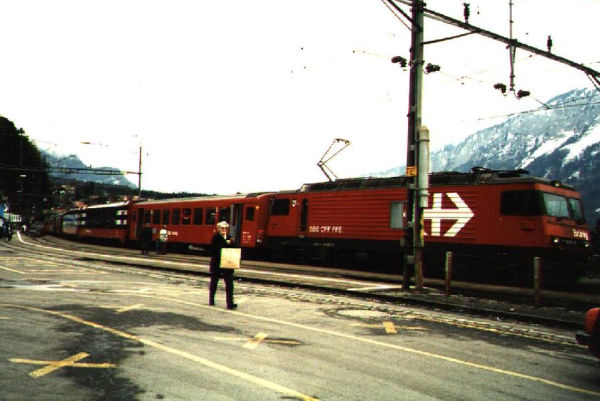
This old picture is still from those times when LSE and Brünigbahn were separate. This was then Brünigbahn's fastest and finest
express train with panorama coaches and a type HGe 4/4 locomotive, here still with large SBB logos on its sides.
Photo by Ilkka Siissalo.
Uploaded May 24, 1999.
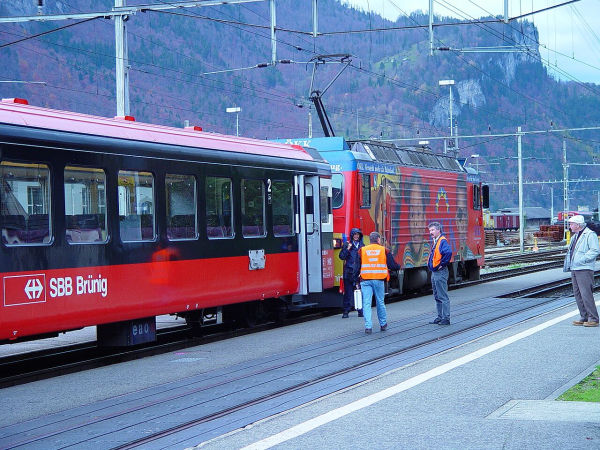
Still from the times when it was SBB Brünigbahn. A train is ready to leave from Meiringen towards Interlaken. But then it was a
rake of old aluminium coaches with an HGe 4/4 locomotive.
Picture from Meiringen 27.10.2002 by Ilkka Siissalo.
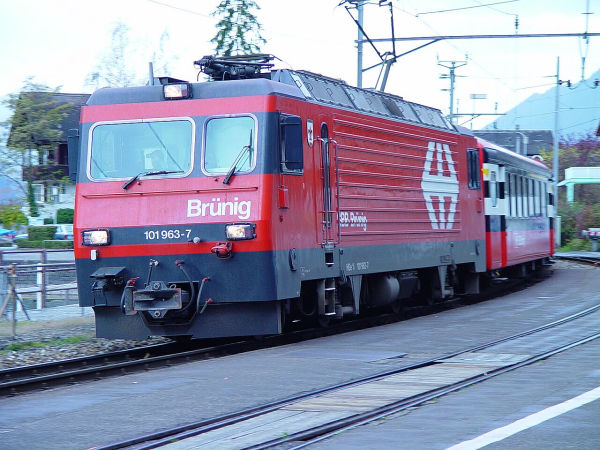
An SBB Brünigbahn train is coming from Interlaken and heading towards Luzern and is here just approaching the station of Brienz.
The locomotive is - of course - again one of the HGe 101 machines.
Picture from Brienz 27.10.2002 by Ilkka Siissalo.
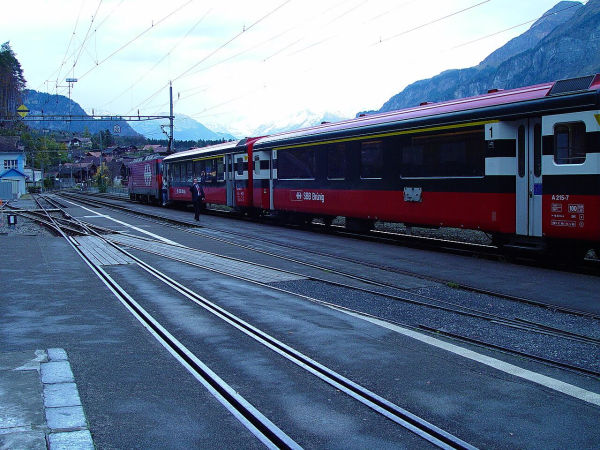
The same train as above, but now after it had stopped at the Brienz station.
Picture from Brienz 27.10.2002 by Ilkka Siissalo.

A closer look at the HGe 101 locomotive of the same train as above.
Picture from Brienz 27.10.2002 by Ilkka Siissalo.
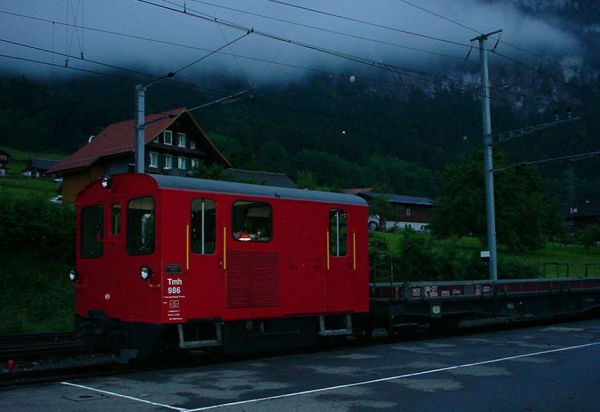
The SBB Brünigbahn narrow gauge combined cog wheel and adhesion railroad small locomotive
Tmh 986 was classified as "cog wheel diesel rail tractor". It was used in maintenance work
on the steep Brünig railroad. Photo from Sarnen station nighttime in June 1999 by
Ilkka Siissalo.
Uploaded June 6th, 2002.
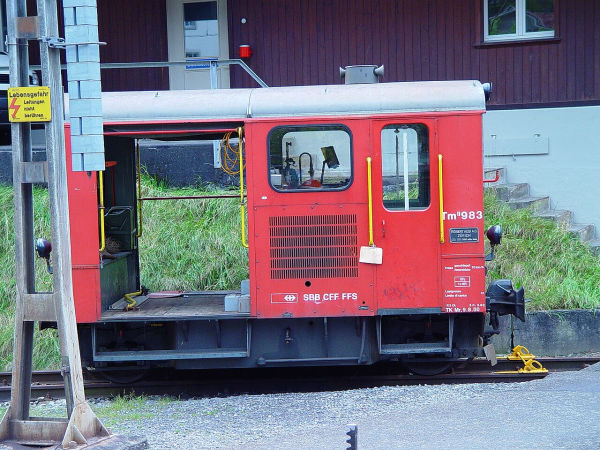
Almost, but not quite similar to the one shown above, the motorised diesel draisine Tm II no.983 was waiting at the Meiringen depot.
Picture from Meiringen 27.10.2002 by Ilkka Siissalo.
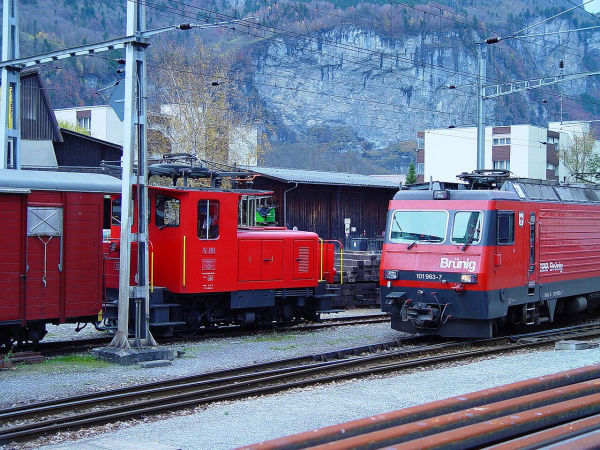
An SBB Brünigbahn class Te III electric rail tractor and an HGe 101 locomotive meeting in Meiringen. Compare the looks of the Te III
with the much later taken photo of Zentralbahn Te 171 shown higher up on this same page.
Picture from Meiringen 27.10.2002 by Ilkka Siissalo.

At Alpnahstadt along the Brünig pass railway line there is a small railway museum, which has preserved old equipment from times long gone.
This is a rotary snow plough Xrot e50 used in former times at the Brünig pass mountain line.
Picture from Alpnahstadt 1.5.2016 by Ilkka Siissalo.
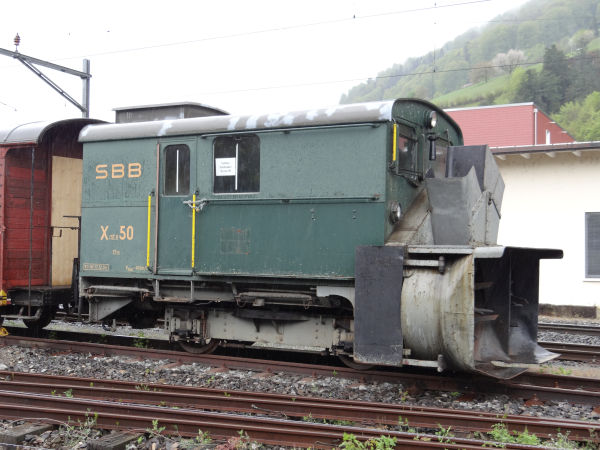
Same rotary snow plough as above.
Picture from Alpnahstadt 1.5.2016 by Ilkka Siissalo.

These class Deh 120 locomotives (actually they were classified as "Triebwagen", motor wagon and not a locomotive, because they had cargo
departments) were built during the times of the second world war. This one was built in 1941. They served long times as locomotives
throughout the Brünigbahn route and then later, deprived of their cog wheel mechanisms as locomotives of flat land commuter trains
in the vicinity of Luzern. This one is kept at a museum at Alpnahstadt.
Picture from Alpnahstadt 1.5.2016 by Ilkka Siissalo.

The same Deh 120 "Triebwagen" as above. This one is now again painted in its original green livery. In the 1990s they were still red.
Picture from Alpnahstadt 1.5.2016 by Ilkka Siissalo.
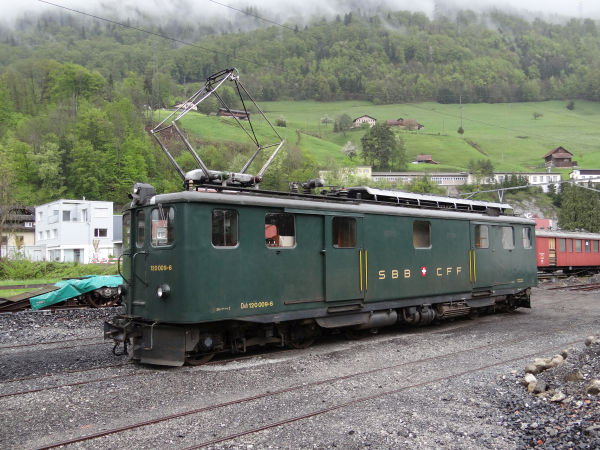
Still the same Deh 120 but seen from the other side.
Picture from Alpnahstadt 1.5.2016 by Ilkka Siissalo.
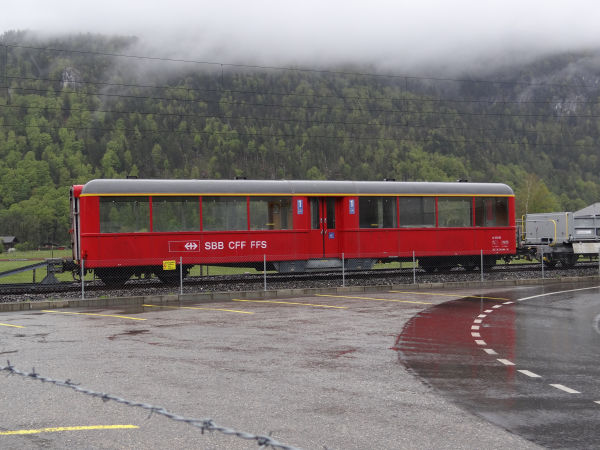
An old first class coach of the former SBB Brünigbahn with large panorama windows sitting idly on a side track near the Meiringen
station. It had several stickers saying "ausrangiert" meaning it has been put out of service.
Picture from Meiringen 1.5.2016 by Ilkka Siissalo.

